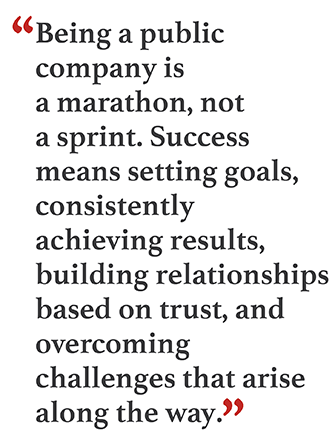
On April 27, 2019, Smartsheet celebrated its first year as a public company. It was an exciting year: We experienced 60 percent year-on-year revenue growth, launched new capabilities, opened additional offices, and completed an acquisition. All these changes happened while we also navigated an update to our selling motion, significant growth in our global headcount, and support for an increasing number of customers—and we began reporting our quarterly results to Wall Street for the first time.
Being in the public arena can be daunting. It exposes the CFO to increased visibility and probing questions from investors and others. I learned in business school that markets are efficient, but my real, on-the-ground experience has taught me that people are emotional and react to information in sometimes unexpected ways. When a company's news or results don't match Wall Street expectations, that disparity can lead to volatility and unintended consequences.
It is always best to minimize surprises and misunderstandings, in order to keep unpredictable reactions to a minimum. Whether your company has been public for years or is a new entrant to the market, here are four pieces of Wall Street advice that I learned from our first year as a public company:
1. Keep prepared remarks brief on earnings calls.
Sell-side analysts (those who write research about your company) and investors (those who buy and sell your stock) cover many companies. Earnings calls frequently overlap, and even when they don't, analysts' and investors' time is very limited. Keeping your prepared remarks brief, but still insightful, gives analysts more time to ask questions before they move on to the next call they need to participate in or report they need to complete.
I was initially surprised when analysts told me they like the length of our prepared remarks. We limit our remarks to 15 minutes total. Our CEO speaks for six minutes, and as CFO, I speak for nine minutes. Those three additional minutes give me adequate time to cover in-depth financial information and guidance, which we share along with accompanying slides so that it's clear and easily accessible to investors.
 It's also important to be thoughtful about the information you are presenting. Our CEO discusses new products, shares customer stories, and provides updates on how our corporate strategy is being executed. However, analysts advised us early on not to repeat what we had already shared, either during the pre-IPO roadshow or on prior earnings calls. We are careful to avoid repeating information we have already made public, unless it's particularly relevant to the message we're trying to convey or a needed reminder about a time-sensitive issue.
It's also important to be thoughtful about the information you are presenting. Our CEO discusses new products, shares customer stories, and provides updates on how our corporate strategy is being executed. However, analysts advised us early on not to repeat what we had already shared, either during the pre-IPO roadshow or on prior earnings calls. We are careful to avoid repeating information we have already made public, unless it's particularly relevant to the message we're trying to convey or a needed reminder about a time-sensitive issue.
Once the earnings call is complete, we provide each sell-side analyst with 15 to 30 minutes of additional one-on-one conversation, and we follow up with investors on request.
2. Be clear when communicating changes.
Investors and analysts are exceptionally intuitive. They listen carefully to what you are saying and notice the smallest changes in strategy or in expectations for performance relative to a specific metric. Any variations may create suspicion that the company is hiding a problem—even if that's not the case. Being consistent in what you communicate is critically important.
It's also crucial to carefully communicate changes to previously communicated plans. Wall Street appreciates you bringing them along on your journey. For example, consider a scenario in which a company is moving forward toward reaching goals it has described on prior analyst calls, but progress is proving to be slower than expected. Even if management expects to eventually meet those objectives, the CEO and CFO need to address the change in timeline. This means being up-front and authentic in sharing why plans are taking longer. One way to avoid getting in this type of situation in the first place is to reveal no information about anything new until it is well-baked. This is the approach of companies like Apple, which introduce a new product only when it's ready to sell.
3. Be transparent and open to being challenged.
Being clear and transparent about what is happening at the company—and (more important) why it's happening—builds trust with Wall Street. The CEO and CFO need to be prepared to not only share successes, but also comfortably answer questions about challenges or improvements that may be necessary.
Investors and analysts will inevitably raise their concerns. They are talking with other companies, potentially including your competitors. They will fact-check what you tell them and investigate your leadership's reputation. It's all part of their due diligence. And while it's okay to disagree with an investor's or analyst's point of view, listening to their concerns as part of a respectful dialogue establishes a healthy two-way relationship.
In a previous role with a different company, I was an investor relations (IR) professional. A sell-side analyst once held a firm "sell" position on our stock. No matter how well we executed, his opinion would not change. Instead of ignoring him, I met with him often so that I could understand his point of view. I eventually became an expert on the perceived downside risks of our business from an outsider's perspective.
This experience taught me that the best response to concerns is to acknowledge them without defensiveness and, if appropriate, explain what you are doing to manage them. I also find that asking for an investor's or analyst's opinion on how to address a concern or challenge can lead to great advice.
4. Be thoughtful about future guidance.
Investors take a long-term perspective. They want to know how you are thinking about not just the next quarter but the next year. The common expectation is that you will provide guidance on a few key financial results. If you don't, you risk investors coming up with their own—often overly optimistic—expectations, and unwittingly setting up the company to miss those expectations. To avoid backing yourself into a corner, I strongly advise that you provide guidance but leave room in your range for potential downside risks.
Companies typically provide guidance on revenue, profitability, and cash flow for the coming quarter and current fiscal year. There's another critical number that investors watch carefully for software-as-a-service (SaaS) companies like Smartsheet: billings. To an investor, this is the leading indicator of revenue to come. Billings can be difficult to forecast, but Smartsheet chooses to provide guidance so that we minimize the risk of missing investor expectations. We take a thoughtful approach, setting the stage by discussing the risks associated with forecasting this metric, such as seasonality and timing renewals of big deals. This provides additional color on the complexity involved ahead of disclosing a specific number.
Here's how I'd summarize my advice from year one: Be brief, be clear, be appreciative of feedback, and guide carefully. When your company misses expectations, explain what happened. Keep learning and improving after each earnings call. Recognize that no one is perfect and misunderstandings happen; the key to mitigating the effects is to quickly clarify and correct anytime a misunderstanding occurs.
Most important, recognize that being a public company is a marathon, not a sprint. Success means setting goals, consistently achieving results, building relationships based on trust, and overcoming challenges that arise along the way.
 Jennifer Ceran is CFO and corporate treasurer of Smartsheet. With more than 30 years of work experience in the U.S. and internationally, she is passionate about creating high-performing teams and scaling businesses. Prior to Smartsheet, Ceran was the CFO of Quotient Technology, Inc. (formerly Coupons.com), VP finance at Box Inc., VP finance at eBay Inc., and director of corporate finance at Cisco. In 2017, she was named CFO of the Year by the Puget Sound Business Journal and was recognized repeatedly in the 2000s by Treasury & Risk as one of the "100 Most Influential People in Finance."
Jennifer Ceran is CFO and corporate treasurer of Smartsheet. With more than 30 years of work experience in the U.S. and internationally, she is passionate about creating high-performing teams and scaling businesses. Prior to Smartsheet, Ceran was the CFO of Quotient Technology, Inc. (formerly Coupons.com), VP finance at Box Inc., VP finance at eBay Inc., and director of corporate finance at Cisco. In 2017, she was named CFO of the Year by the Puget Sound Business Journal and was recognized repeatedly in the 2000s by Treasury & Risk as one of the "100 Most Influential People in Finance."
© Touchpoint Markets, All Rights Reserved. Request academic re-use from www.copyright.com. All other uses, submit a request to [email protected]. For more inforrmation visit Asset & Logo Licensing.


